House Moth Identification
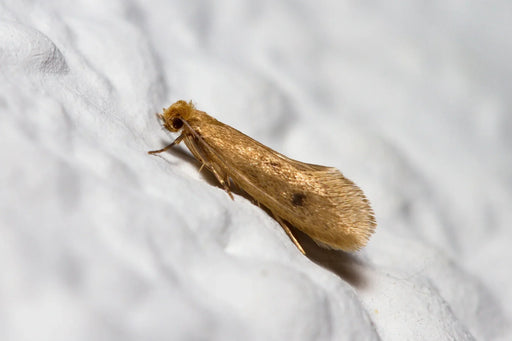
Finding a moth in your home is going to raise a lot of questions. How did it get here? Is the moth after your clothing or is it harmless? You might even wonder if finding a single moth is worthy of concern. Even one adult moth raises the chance of an infestation, so you need to know what to look for and how to protect your home. The first step? Knowing how to identify the moths in your home.
What are Moths?
It is believed that there are at least over 160,000 types of moths that we know of, but there are more species that haven’t even been researched yet. While moths are closely related to butterflies, their food sources are different. Compared to the vibrant colours of butterflies, the majority of moths that you see in your home are neutral colours, like grey, brown, white, and cream.
Moths rest their wings flat against their back, which is one defining feature that can help you with household moth identification and guide your choice in moth prevention products.
Types of House Moths
When people talk about household moth identification, they are typically talking about two categories: Pantry Moths and Clothes Moths. The species of moths in each category have similar appetites, but their behaviour, appearance and lifespan differ slightly from 30 - 45 days. Using the right moth prevention moth traps can help control both.
Pantry Moths
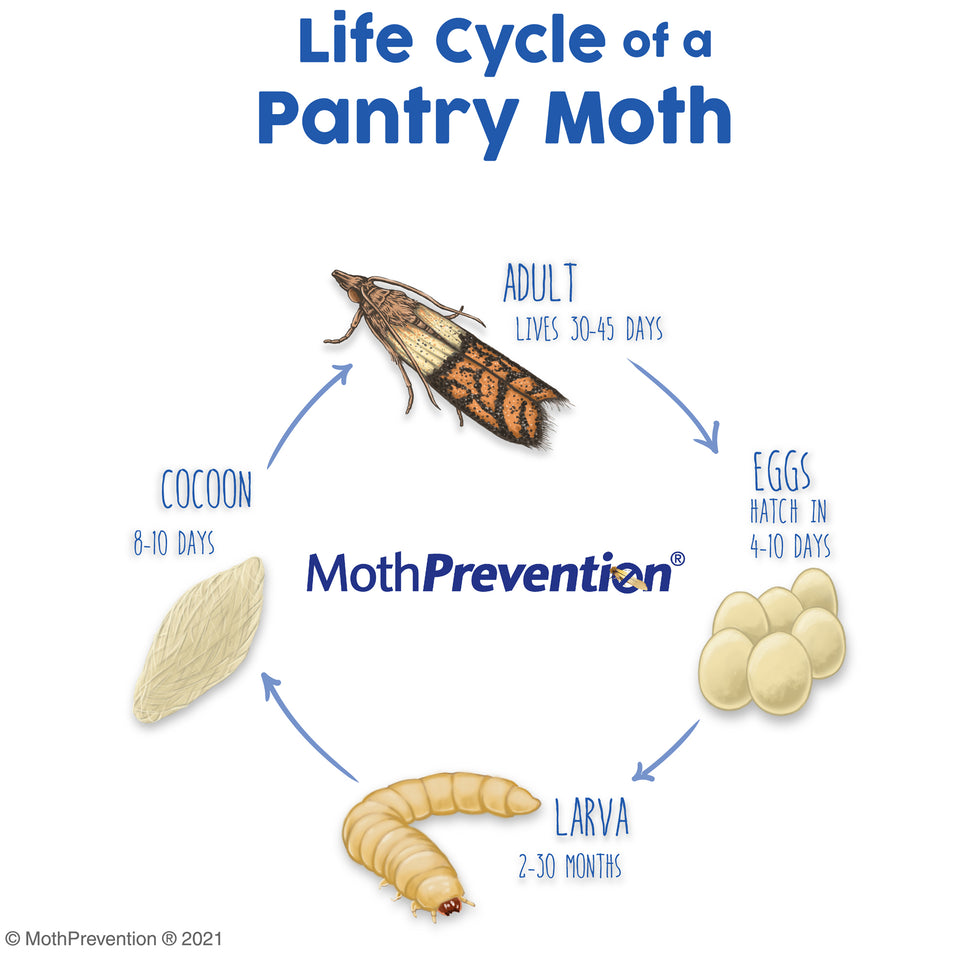
As you may be able to guess, a Pantry Moth is found in the pantry! They thrive anywhere where unprotected grains are found, including rice, cereal, dry pet food, crackers, and similar goods. They may even target nuts, dried fruit, spices, and chocolate.
Generally, Pantry Moth larvae leave behind silken webbing and excrement, and will be seen squirming around inside bags of flour or containers. There are four common types of pantry moths to keep an eye out for:
Mediterranean Pantry Moth

Protect your flour. The Mediterranean Pantry Moth is a highly damaging moth. While these moths tend to go after flour, they will also lay eggs near breakfast cereal, dried grain, bran, and oatmeal. An infestation can be identified by the larvae's silken webbing that causes the food source and moth larvae to clump together. Effective pantry moth prevention may involve both cleaning and setting up moth prevention traps.
Mediterranean Pantry Moths are a grey colour with black zigzags on their wings. The hind legs are an off-white colour. When fully grown, these moths are about 23mm long. They also have a resting pose where the forelegs are extended above the head, so the body slopes. No other pantry moth does this.
Larvae can be white or slightly pink and have a dark head. Some have black dots on the body.
Brown House Moth
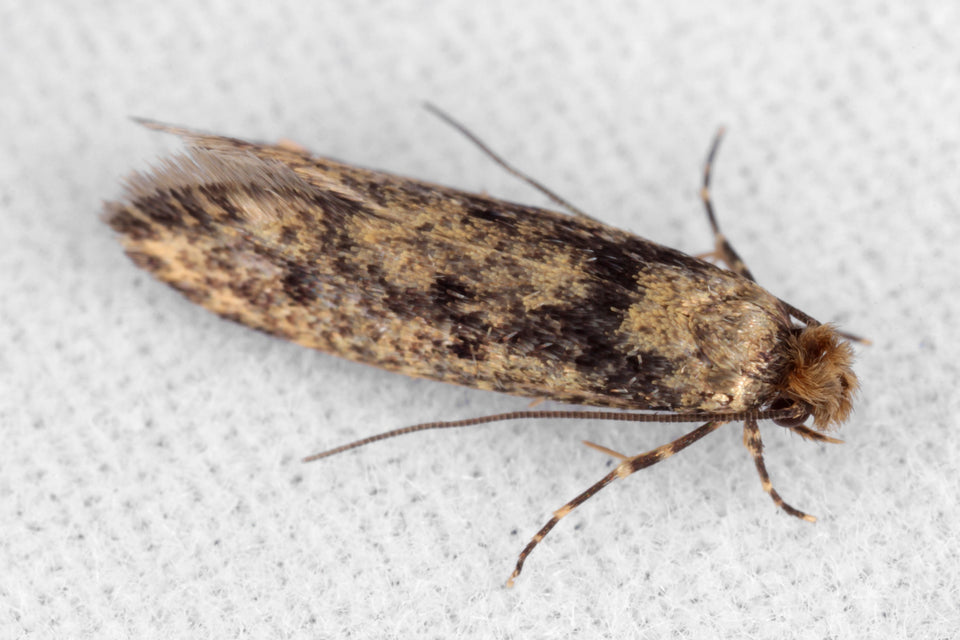
The Brown House Moth (Hofmannophila pseudopretella) is thought to have originated in Asia. While falling into the pantry moth category, Brown House Moths will be found throughout the home. An adult Brown House Moth is about 8-14mm long and has a 15-26mm wide wingspan. The wings are usually shades of brown mottled with darker spots on the wings and body.
You can find the larvae in the pantry, carpets, and clothing. A larva is about 6mm long and has an off-white body with a light brown head. They feed on dried food, flour, rice, oatmeal, potatoes, bread, and even natural fibres woven into clothing and other textiles.
Both pantry moth traps and carpet moth traps are helpful for tackling this species. For long-term control, consider moth prevention products like moth proof clothes bags.
White Shouldered House Moth
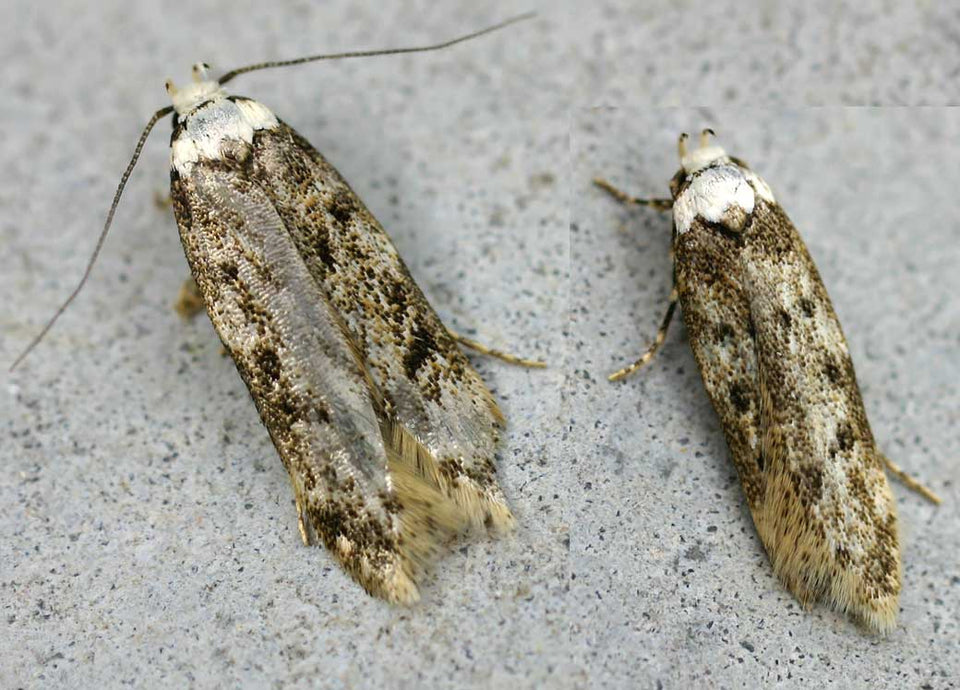
Attribution: © entomart
Attracted to light, the White Shouldered House Moth (Endrosis sarcitrella) is found fluttering around light bulbs within homes, factories, and other buildings. Warmer temperatures and central heating will keep adult moths active throughout the year, and the larvae are omnivorous. Moths will lay their eggs on a food source suitable for their larvae. For example protein-based fibres such as wool, fur, feathers, leather and suede. They also eat anything with grains, such as bran cereal, flour, seed, dried beans, legumes, and oatmeal.
The defining feature of White Shouldered House Moths is the white head and white patch on the upper shoulders. They have long brown antennae, a light brown base with some fringe on the wings, and darker mottling throughout. The ends of the wings are also tapered. Adults are between 6.3-10.5 mm long, with females being larger; the wingspan is 10-25mm. Their larvae have red heads and cream bodies.
Indian Meal Moth
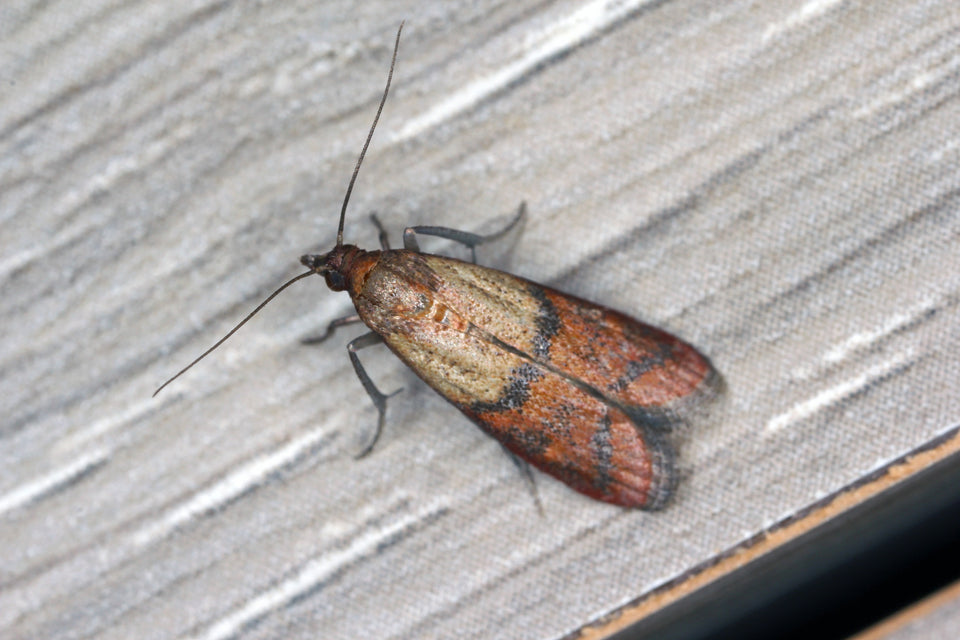
Many people seeking out house moth identification are looking for information on the Indian Meal Moth (Plodia interpunctella), also known as Flour Moths or Pantry Moths. These moths have a unique appearance, including a small bronze coloured head, bronze shoulders, and a patch of light brown on the upper body. The ends of the two-tone wings are darker, with a slight fringe.
Adult Indian Meal Moths grow about 8-10mm long and have a wingspan of 16-20mm wide. The larva has a brownish head and cream coloured body. Adult Meal Moths prefer dark, cool places and will lay their eggs anywhere they can find unprotected cereal, dried fruits, vegetables, bread, flour, pasta, rice, nuts, and even chocolate!
Evidence of an Indian Meal Moth infestation comes in the form of the larvae wriggling within food, or the discovery of food bound together by webbing. These signs mean it’s time to act with pantry moth pheromone traps and other moth prevention products.
Clothes Moths
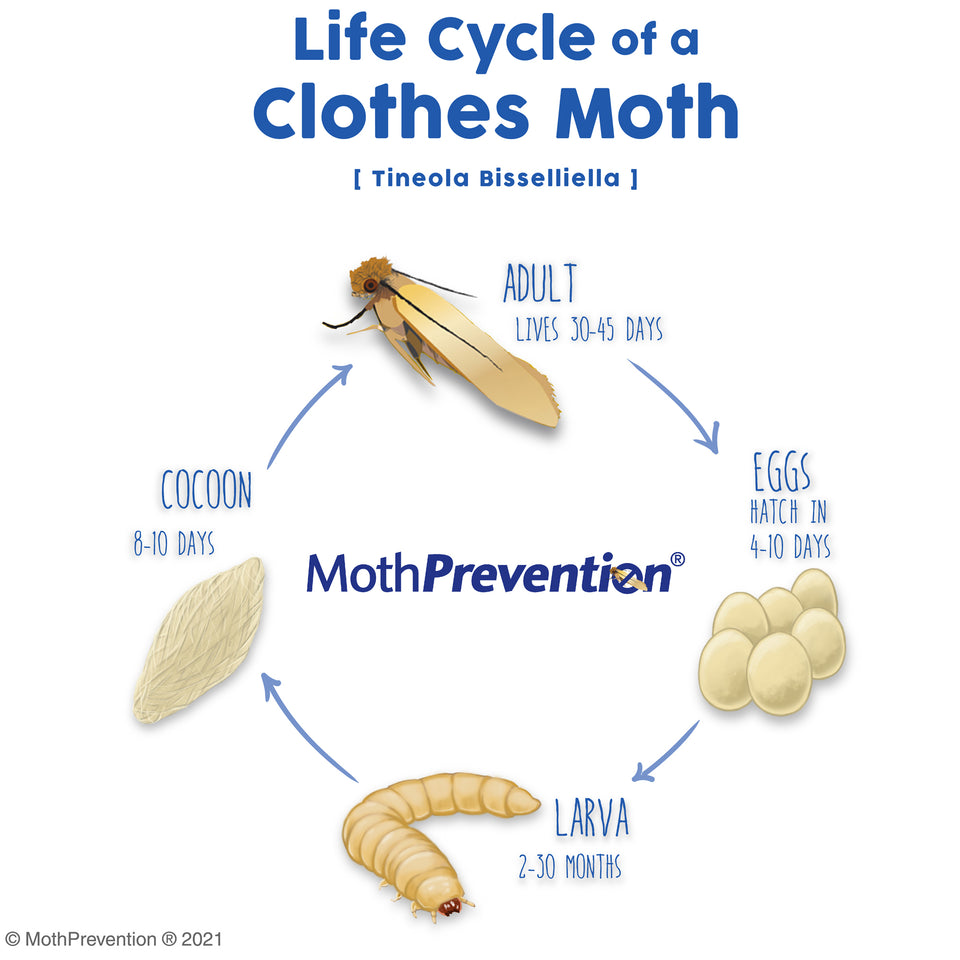
Unlike Pantry Moths, Clothes Moths target protein-based fibres such as furs, silk, wool, and linen. You will find these moths in dark undisturbed spaces such as your attic, closets or basement. Clothes moth prevention starts by monitoring these areas and setting up clothes moth traps and using moth proof clothes storage.
Signs of a clothes moth infestation include:
- Silken strands /webbing
- Excrement with the appearance of small grains of sand
- Holes in clothing
- Long, cylindrical silk cases, sometimes occupied by larvae
Webbing Clothes Moth or Common Clothes Moth

One of the most commonly confronted and damaging in this list is the Webbing Clothes Moth (Tineola bisselliella). These are small moths, reaching about 6-7mm in length when mature. Characterised by white antennae, a fuzzy brown head, and fringed white wings, they often crawl around rather than fly.
The larvae are longer, about 10mm long and infest a wide range of materials made from natural fibres; including your knitwear, carpets, rugs and other textiles.
Case-Bearing Clothes Moth

Rarer than the Webbing Clothes Moth, the Case-Bearing Clothes Moth (Tinea Pellionella) has a larva that fabricates a tube of silk fibres and food debris around itself that adheres to their bodies as they eat. The tube looks a bit like a grain of rice, but if you look closely, there will be the brownish-red head of a larva protruding out of one end.
Case-Bearing Clothes Moth adults are darker than the common clothes moth, 6-7mm long, and have a trio of spots on their wings.
FAQs for House Moth Identification
Now that we have discussed what moths are, the types of moths to watch out for, and their life cycles in-depth, let's go over some frequently asked questions on the topic. After all, sometimes, you’re simply looking for fast, straightforward answers. Hopefully, these FAQs will help you feel more confident in common House Moth identification, Clothes Moth identification, and more!
What do Brown House Moths look like?
Adult Brown House Moths, scientifically known as Hofmannophila Pseudospretella, have reddish-brown or brownish-gray colouring. They may also have shaded patches on their backs. The wings often have spots, are tattered at the edges, and can be bronze or brownish in colour as well.
Usually, these moths measure between 8 and 14 mm long and have wingspans of 15 to 26 mm. The larvae of Brown House Moths are slightly smaller than the larvae of other species and tend to be an off-white colour with darker-coloured heads.
How to identify Brown House Moths?
With Brown House Moth identification, the main things to keep in mind are appearance and location. These moths are brown, brownish-gray, or bronze-brown in colour and are weak flyers. The ravenous larvae of these moths can be found eating keratin or cereal proteins. This may include wool, leather, fur, grains, or other exposed dry foods. If you have larvae or adult moths infesting your pantry, closet, or cupboards, Brown House moths may be to blame. Use moth traps and targeted moth prevention products to break the lifecycle.
What do House Moth cocoons look like?
With house moth cocoon identification, you will be looking for long, oval-shaped casings. These casings can be found in garages, closets, drawers, crevices, beneath furniture, in food storage bins, and more. Usually, these casings are a tan or off-white colour. However, they can also be brown or light yellow. Detecting cocoons early can help with faster moth prevention in the home.
How to identify Clothes Moth Larvae?
Clothes Moth larvae identification involves carefully inspecting garments, furniture, or other materials for the presence of small brownish or yellowish worms. Usually, these larvae are shiny and white in colour with heads that are a darker shade, ranging from tan to brown. Webbing Clothes Moth Larvae spin web-like cocoons as they feed. Case Bearing Clothes Moth Larvae may leave oblong or cylindrical casings behind as they grow.
Clothes Moth Larvae will tunnel through items that contain animal based fibres such as leather, silk, cashmere, wool, feathers, and so on while feeding. The presence of dead moth larvae or adult moths is another sign that these pest moths may be lurking nearby.
Do I need to hire an expert for moth pest identification?
If you realise that your home is infested by moths, hiring an exterminator for help may seem like the best option. For serious infestations, a professional pest control service may indeed be the best possible solution. However, oftentimes, homeowners find that they can remove these pests without the help of professionals. The process involves identifying the most heavily infested areas, thoroughly cleaning, and implementing future preventative measures such as pheromone moth traps.
What kind of moths come into your house?
The most common types of moths that infest homes are Clothes Moths and Pantry Moths. There are many subspecies of both of these moths. Pantry Moths tend to infest pantry and cupboard spaces and lay eggs that hatch into larvae which eat grains, cereals, flour, and other dry goods. Clothes Moth Larvae feed on fabrics or materials that contain the protein keratin which is found in animal based fibres. This may include wool, silk, cashmere, leather, feathers, and more.
Why do I suddenly have moths in my house?
Moth infestations most often come from Clothes Moths, Pantry Moths, or migrating moths. With migrating moths like Millers, an infestation will usually occur suddenly in the warmer spring or summer months. Pantry Moths and Clothes Moths can mature into adulthood from larvae simultaneously, causing what appears to be a sudden swarm from the pantry, closet, etc.
While migrating Millers are annoying, they do not generally cause damage to your home. However, Clothes Moths and Pantry Moths can both be incredibly detrimental to stored items like dry food goods or clothing.
Are there any other “moth in my house identification” tips to keep in mind?
If you are searching for “moth identification house tips”, there certainly are plenty of anecdotes available online. The main points to keep in mind when identifying moths in your house are where you have found an infestation, and whether there are any signs of larvae present. From there, you can usually figure out which kinds of moths you need to remove.
Here are a few tips to help you with common House Moth identification:
• Clothes Moths tend to infest quiet areas in homes where natural fabrics like wool or leather are available for their larvae to eat.
• Pantry Moths will usually be, as the name suggests, in your pantry or cupboards, so that they can lay eggs in dry goods like flour or cereals.
• Pestilent House Moths (like Clothes Moths and Pantry Moths) are weak flyers and shy away from light, seeking dark spaces to hide in.
• Clothes Moths and Pantry Moths are both small, measuring less than 14 mm long. You may see adult moths flying around, but also notice larvae infesting a drawer, cabinet, or food item in the pantry.
About MothPrevention
MothPrevention® speak to customers every day about their clothes moth issues - clothes moths are a species that are ever increasing and that can cause significant damage to clothes, carpets and other home textiles.
To date, we’ve helped over 250,000 customers deal with their moth problems. We have developed professional grade solutions including proprietary pheromones and trap design engineered to the highest production standards.





